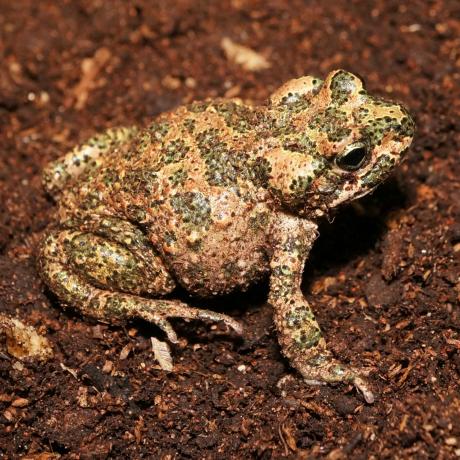

Also known as the Brongersma’s toad, this small species would make a great addition to any serious amphibian collection.
| Origin | Western Sahara |
|---|---|
| Environment | Arid to Semi-arid landscape |
| Adult Size | Up to 5cm |
| Suitability | Novice |
| Lifespan | Unknown |
A small but broad species of toad that has a relatively pointed muzzle and large rounded parotid glands.
Their colouration is variable, although generally they have a beige-yellow or reddish background colour, along with a marbled pattern of green and small dark spots.
Females are larger than males when they reach adult and during the breeding season, males develop nuptial pads and subgular vocal sacs.
Found in varying localities across the coastline of Morocco from Agadir to Meseied. Also believed to be present in isolated regions of Algeria.
Their natural habitat is dry, rocky, and commonly includes Argan Trees, spiny cactus-like succulents, shrubs and grasses.
Observations of this species in the wild, records them most often by pools, streams, and man-altered crop fields.
Temperatures should be maintained between 24-26°C (75°F) during the day, with a night-time temperature drop to 20°C (68°F). This can easily be acheived with an overhead canopy and low wattage basking bulbs.
Although, these toads are nocturnal, we still believe it to be beneficial to provide some form of low level UVB, as they will undoubtedly get exposure in some form in their natural habitat.
Due to this toad being from semi-arid regions, a part land, part water setup in a glass terrarium, would suit them best. We’d advise creating a banked and fairly dry substrate on one side of the terrarium, and a pooled water area on the other. This could also be achieved by having a large water bowl on one end of the terrarium.
When misting or filling water bowls, remember that all tap water must be treated with a good quality dechlorinator.
For décor, use live plants suitable for drier environments or artificial plants for easy maintenance and cleaning. Combine this with various woods, branches, and rocks to create natural hideaways for your toads.
Feed babies and juveniles four to five times and adults two to three times weekly on a varying and suitably sized diet including crickets, mealworms, curly-wing flies and locusts.
Lastly and most importantly you must use a good quality dusting powder to provide essential calcium and vitamins to your toads. The traditional method of application is to use a spare live food tub or empty cereal container to coat the insects lightly in whichever dusting powder you are providing. We’d advise dusting your insects on every feed for young toads when they are growing but to alternate between calcium and vitamin powders with the ratio of (2.1).